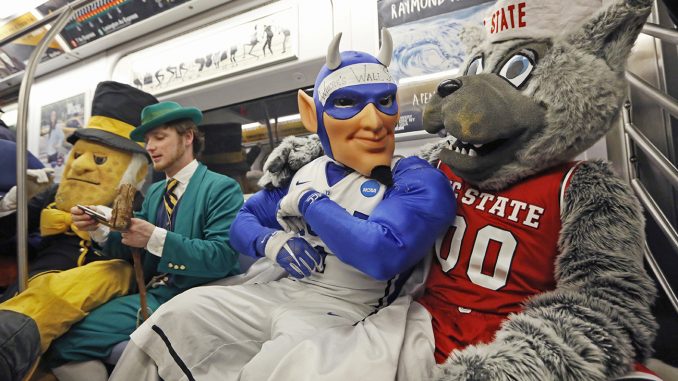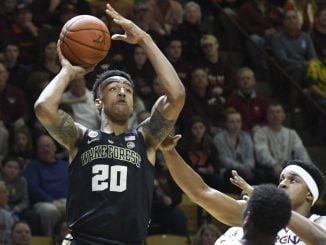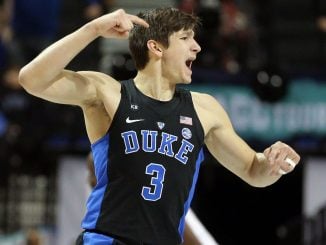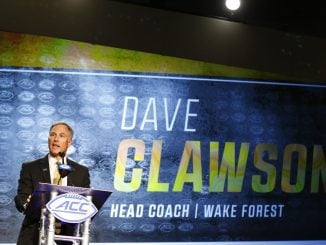
In a landscape filled with Tigers, Knights, Bulldogs and Bears, North Carolina’s colleges have perhaps the most diverse set of nicknames as any state in the country. Sure, we might have a Wildcats and a couple Bulldogs, but no one else can claim a Demon Deacon or Fightin’ Camel.
Over the next few weeks, we’ll look at the origin of the nickname for each of North Carolina’s Division I schools, which is, at times, even crazier than the names themselves. Which team was named after an angry letter to the newspaper? Which mascot nearly killed a member of the opposing team’s band? Which school was nearly named after a ground squirrel found on campus?
We start off with the Big Four — North Carolina’s ACC teams.
Duke Blue Devils

Back when Duke was still known as Trinity, the student newspaper — The Chronicle — got tired of referring to the football team as The Trinity Eleven, The Blue and White, and The Methodists (to differentiate it from the Baptists at Wake Forest). They held a contest to name the team in 1921. Nominees included the Dreadnaughts (a famous battleship), The Polar Bears and The Royal Blazes. The paper eventually chose to name the team after a group of French soldiers who fought in the Alps during World War I, who were known for using trench warfare and their flowing blue capes. They were known as the Chasseurs Alpins and nicknamed “les Diables Bleus” — the Blue Devils.
The Blue Devil mascot is apparently much tamer than it used to be. During the 1933 game against UNC, he threw his trident like a spear and accidentally stabbed a member of the UNC band in the back during the halftime show. According to The Daily Tar Heel, “The fork was cut in an emergency operation on the field by a member of Duke Hospital’s staff.” He suffered a deep puncture of the superficial back muscle with no organ damage.”
North Carolina Tar Heels

The state university of the Tar Heel State adopted North Carolina’s nickname as its own, although the sports teams were referred to as the White Phantoms for a time early in the 20th century. It was originally an insult for low-class Southerners who worked barefoot in the forest. During the Civil War, it became a credit to the state’s soldiers for their willingness to stay stuck in place no matter how fierce the fighting, as if they had something sticky on the back of their feet.
Why a ram? That dates back to 1924 when UNC’s football team was led by star fullback Jack Merritt, who was known as “The Battering Ram.” The cheerleaders purchased a ram for $25 to bring to pep rallies in his honor.
NC State Wolfpack

NC State’s nickname supposedly came from a shocked and outraged fan who wrote to the student newspaper, The Technician, in 1921 to complain about the behavior of some of the players on the football team.
According to legend, the letter (which does not appear to have been published) said that the players were “unruly as a pack of wolves,” although the nature of their misbehavior appears to have been lost to the ages.
State embraced its unruliness and the name stuck. By November 1921, The Technician was using the name in poems dedicated to State’s win over UNC. “Our wolves made history on that date,” the ode proclaimed, and “Carolina threw a mighty scare into the Wolfpack’s camp … That Wolfpack line held like a wall.”
Prior to that, State’s teams were known as The Techs, Farmers, Aggies and Mechanics at various times. The basketball team was known as the Red Terrors after they got new bright red silk uniforms, supposedly in honor of team captain Rochelle “Red” Johnson.
Only the football team used Wolfpack until, in 1946, chancellor John Harrelson asked students to come up with a new nickname since “the only thing lower than a wolf is a snake in the grass.” Nominees included The North Staters, Cardinals, Hornets, Cultivators, Cotton Pickers, Pine-rooters, Auctioneers and Calumets. The most popular choice, however, was to stick with Wolfpack, which was then adopted by all of the school’s teams.
Wake Forest Demon Deacons

Wake Forest was known as the Tigers in the late 1800s, but the name never really stuck. For the first two decades of the 20th century, Wake was referred to as The Old Gold and Black or The Baptists, but, for all intents and purposes, by the 1920s, the school was the last one in the state to have a true nickname for its sports teams.
Then, in 1923, Wake’s football team upset its rival, Duke (then still known as Trinity College), 16-6. Playing off of Duke’s nickname, the game story in the student newspaper referred to Wake’s “devilish” play. With Wake’s own Baptist tradition, the writer coined the term Demon Deacons, and it stuck.



